|
Join Date: Sep 2007
Location: UK
Posts: 4,033

 |
Crop Factor
The Crop Factor
Lets start with the basics.. As we all should know "traditional cameras" had to be loaded with film. Each frame of the film was measured at 35mm. We now have Digitial cameras which have an "electronic film". This is called the sensor. If you compare the size of traditional film to that of the image sensore in your DSLR, you will find that the sensor is generally smaller.
If you take a photo with a smaller sensor than traditional film, with the same lens, your final image will show a smaller area of the scene. This can be overcome by using full frame cameras. These are made with film sized sensors, but are generally more expensive.
Each camera model will have its own crop factor from anywhere between full frame, through to 1.6x
Below is an image which shows how much your imaged will be cropped (dependable upon your cameras sensor size) in comparision with 35mm film or full frame cameras.

35mm film/Full Frame
1.3x Crop Factor
1.5x Crop Factor
1.6x Crop Factor
As a result, when you fit a lens (which are standard made for 35mm/full frame cameras) to a camera with a crop factor, the lens is often said to have a larger equivelent lens size. However, this can throw in alot of confusion for many photographers, as its a misleading trm which gives the impression you are gaining focal length, this is not the case, you have infact the same field of view.
Crop Factor Table
This table shows you the equivlent field of view for each "cropped sensor" paired up with some popular lens sizes.

Lets start with the basics.. As we all should know "traditional cameras" had to be loaded with film. Each frame of the film was measured at 35mm. We now have Digitial cameras which have an "electronic film". This is called the sensor. If you compare the size of traditional film to that of the image sensore in your DSLR, you will find that the sensor is generally smaller.
If you take a photo with a smaller sensor than traditional film, with the same lens, your final image will show a smaller area of the scene. This can be overcome by using full frame cameras. These are made with film sized sensors, but are generally more expensive.
Each camera model will have its own crop factor from anywhere between full frame, through to 1.6x
Below is an image which shows how much your imaged will be cropped (dependable upon your cameras sensor size) in comparision with 35mm film or full frame cameras.

35mm film/Full Frame
1.3x Crop Factor
1.5x Crop Factor
1.6x Crop Factor
As a result, when you fit a lens (which are standard made for 35mm/full frame cameras) to a camera with a crop factor, the lens is often said to have a larger equivelent lens size. However, this can throw in alot of confusion for many photographers, as its a misleading trm which gives the impression you are gaining focal length, this is not the case, you have infact the same field of view.
Crop Factor Table
This table shows you the equivlent field of view for each "cropped sensor" paired up with some popular lens sizes.

|
Join Date: Sep 2007
Location: South Wales, UK
Posts: 15,385

 |
Nice one K, added to sticky!
|
Kit 1 Nikon D300 Nikon 55-200mm VR |
Kit 2 Nikon D40 Nikon 18-55mm |
|
|
My Compact/P&S: Panasonic Lumix TZ7 |








